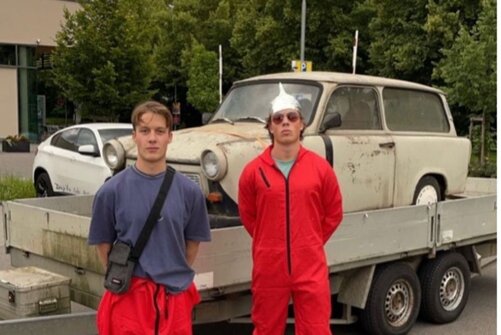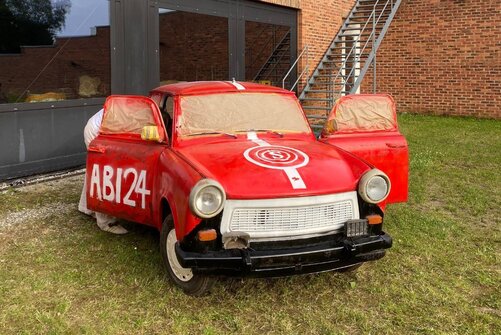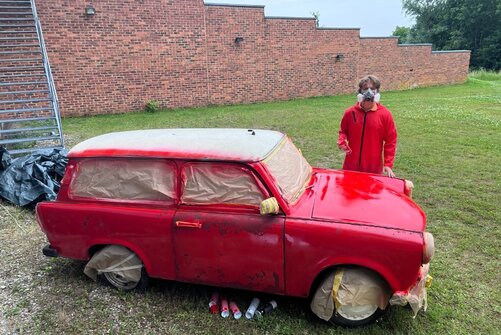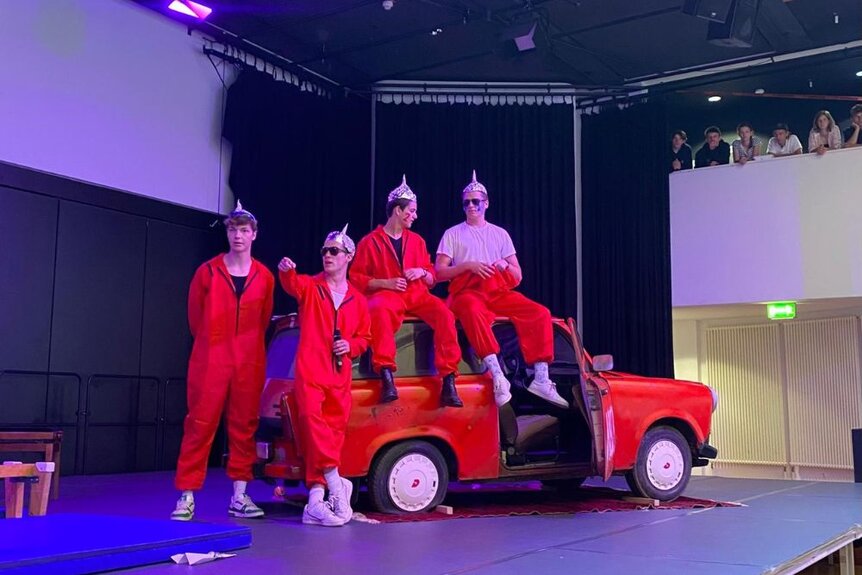A Trabi Named Honni
Dear readers, what comes to mind when you hear the word car?
Personally, I think of a journey. A journey that begins when one opens a door and gets in and ends when one opens the door again and gets out. A journey that rarely goes exactly as planned, is sometimes shorter, sometimes longer. For some easy, for others not. The sun may shine for some, while others face thunderstorms. A journey full of formative highs and lows, unforgettable moments, learning experiences and, above all, valuable lessons.
One could well compare one’s time at Salem to such a car journey. It begins when you first open the door to your room and ends when you close it for the last time. And just like a journey, this time rarely follows a set route. For some longer, for others shorter, at times difficult, at times smooth. But without doubt, it's a deeply formative time, full of memories, challenges, personal growth and, above all, lessons.
So, what better symbol for this journey, dear reader, than a car? That’s exactly what my brother Magnus and I thought in the weeks leading up to the Abitur exams in June 2024. Our idea for the first Abistreich (senior prank) was to buy a car that the entire year group would help design and then unveil on stage as a symbol and a legacy.
The only problem? We had next to no money. So, we scoured the internet, calling every scrapyard near Überlingen. All to no avail. Until one day we stumbled across an eBay listing that seemed too good to be true: “Selling 1970 Trabant 601. No papers, no engine, cash only. €110.” The seller was a Hungarian man named Attila N., who ran a scrapyard not far from Überlingen. And he wasn’t just selling any car—he was selling a bona fide Trabi. For €110! It had to be fate. After a few phone calls, Attila agreed to deliver the car himself. A risky move as no one else knew about this, especially not the school administration. The car would need to be smuggled directly onto campus; past classrooms, House 25, the academic office and the dining hall, all without anyone noticing. And getting it there was only the beginning. We’d need to fix it up and decorate it on school grounds, all without the knowledge of certain key figures, or even our fellow students. To make matters more complicated, the school rules state quite clearly:
Which only made the whole thing all the more exciting. A little risk never hurt a bold spirit! So, we asked Attila to deliver the Trabi to the nearby Edeka car park first. From there, we’d figure out how best to sneak it in. The plan: bring it onto campus after dinner but before Silentium, when the younger students would be back in their houses, the dining hall empty and the library mostly clear. And unbelievably, at 7 p.m. sharp, a massive pickup truck rolled into the car park, with a battered old Trabant 601 on the trailer and a cheerful Hungarian at the wheel. It was time to act. We decided to play it bold by driving straight onto school grounds and unload the car behind the theatre, just beneath the dining hall.
To get there, we had to cross a lawn, and a Trabi isn’t exactly subtle. So, we relied entirely on luck. Or, as Attila put it: “Shit, boys, I hope no one sees us and we don’t get into trouble.” With much creaking and groaning, the Trabi was slowly and very conspicuously offloaded. Miraculously, no one saw us. The dining hall was empty, the library sparsely populated, and almost everyone was in their houses, including the house tutors. We handed Attila his money and set about hiding the car under a massive tarp we’d used before. On it, we taped a paper sign that read: “ART CLASS A-LEVEL PROJECT. DO NOT TOUCH.” None of us were in the art class. The location was perfect—close to the stage, out of sight from House 25 and the classroom block, and hidden by two brick walls. It was, quite literally, hidden in plain sight.
We began the restoration. The car was in dreadful condition: filthy, rusted, cloudy windows, peeling paint likely untouched since the GDR, and a rather aromatic interior. But from the first moment, it was magical. It had over 500,000 kilometres under its belt. The valuables had been stripped out, but the panelling, seats, and interior were original, untouched since its East German glory days. Beneath the driver’s seat: an old fire extinguisher. The car could still roll, steer and brake, just not drive on its own. You couldn’t help but wonder: What had this car seen? Who had owned it? Was it used in a daring escape? Where had it been? The Trabi felt like a time capsule, and we were hooked. A group of highly motivated classmates joined the mission. First, I wrote an e-mail to our Head of Boarding, Dr. Schwarz. A bit awkward as there was no way to ask permission, since the car was already here. So, I wrote a very polite message, explaining it was a year group project, asking him to keep it confidential, and essentially saying: “Dear Dr. Schwarz, it has arrived.” Technically, it wasn’t a car as it had no engine, after all. Next, we secretly informed our year group and collected donations for paint, tools and decoration. We asked for volunteers and design ideas, and we were fortunate to have many enthusiastic and even artistically gifted classmates. While most students were in lessons or in the bib, we cleaned the car thoroughly, gathered our supplies and ideas, and got to work.
First, we painted it bright red. The headlights and windows were carefully masked off, and we added a white grill and black bumpers. A snowy white racing stripe stretched from bonnet to boot. Students decorated it using stencils: one side read ‘ABI 24’, and on the racing stripe: a beautifully detailed Salem logo. Special thanks must go to Viola H., whose meticulous handiwork brought the logo to life and ensured the colours had clean edges. My brother and I made a final trip to the hardware store to pick up stickers. We named the car Honni and applied the name in bold letters, alongside a few cheeky DDR-themed decals. The car was ready and it was time to present it. The plan? To hijack a school assembly and turn it into our very first Abistreich. With the entire year’s help, I created an elaborate, tailored PowerPoint presentation.
At 6 a.m. one fateful Friday, with the help of the ever-kind caretakers, Honni was lifted onto the stage by forklift. When the assembly began, six boys in red jumpsuits and aluminium hats were crammed inside the sweltering, claustrophobic car. Outside, the hall had been transformed. Music blared, students rushed about in character, some with tin foil hats, others without, all in high spirits. Then, amid sirens and roaring sound effects, the car was unveiled by my twin brother: a spectacular surprise. The Year 11s and many teachers had no idea there even was a car. The six (very sweaty) students climbed out and proceeded to run the entire assembly themselves. The programme included intense teacher-vs-teacher pillow fights, stein-holding contests and karaoke battles in front of the whole school. Honni stayed on stage until our very last day, having a final grand appearance during our graduation ceremony, which my brother and I hosted, but this time in suits, not jumpsuits.
Today, Honni lives in the fire brigade garage, where it’s used for training exercises. A silent witness to an unforgettable time, a monument to boundless fun, cherished memories, and the unique bond of a year group I feel incredibly lucky to have been part of. And if he hasn’t been scrapped by now, dear reader, he’s probably still rusting away to this day.
But there’s one last thing we haven’t yet discussed. At the start of this story, I described each student’s time at Salem as a car journey. Every journey has a start—and an end. So, what, you might ask, was the destination of ours? Was it the Abitur? No. It was much more than that. The journey itself was the destination: a road leading to deep gratitude, incomparable beauty, and ultimately, to a place of belonging, in the extraordinary family that is Salem.




